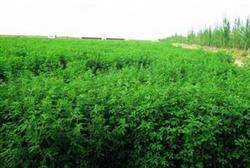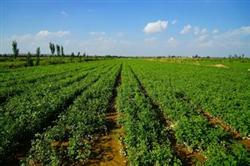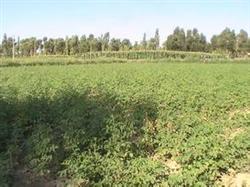Cultivation techniques of licorice seedlings

Abstract: licorice is the material source of a large number of traditional Chinese medicine preparations, and it is widely used in food, beverage, tobacco, daily chemical industry and other fields. However, due to the lack of wild licorice resources, artificial planting needs to be strengthened. In order to improve the seedling planting technology of Glycyrrhiza uralensis, an experiment on seedling cultivation of Glycyrrhiza uralensis was carried out in Urumqi grassland Station. Chinese classification number: S54 document identification code: B article number: 1003-4889 (2007) 04-0046-02 Glycyrrhiza uralensis is an excellent leguminous forage, mainly produced in Inner Mongolia, Gansu, Ningxia and other places in China. It is one of the important resource plants in the western region. Licorice has excellent properties such as cold resistance, heat resistance, saline-alkali resistance, strong adaptability and exuberant vitality. Licorice also has extremely high nutritional value, with a crude protein content of 14.08%, similar to alfalfa and Caragana caragana, a dry legume forage, and 2.10% less than red bean grass. Its crude fat content is 3.45%, 4.49% and 3.55% higher than that of alfalfa, red bean grass and Caragana Caragana, respectively, and its crude fiber content is correspondingly reduced by 1.65%, 6.88% and 11.58%. Its output reward is slightly higher than that of alfalfa. With the in-depth study of licorice, the new use of licorice is changing with each passing day, entering the field of people's daily life, and is widely used in food, beverage, tobacco, cosmetics, chemical, brewing, national defense and other industries, the market demand is increasing day by day. The price has also risen from 700USD / t in 1981 to US $3000 / t now. However, over the years, 80% of the licorice sold by people is wild, which has not only seriously damaged China's natural grassland resources, resulting in a large area of soil desertification, but also a sharp decline in the distribution area of wild licorice. To this end, the State Council issued a notice prohibiting the collection and sale of hair vegetables, stopping the indiscriminate mining of licorice and ephedra, implementing special management of licorice and ephedra, and stepping up the intensity of investigation and punishment. It is obvious that in order to solve the problem of supply and demand of licorice and the contradiction between the export of licorice products and China's environmental protection, the most important thing is to vigorously promote and support the development of artificial cultivation of licorice. At the same time, improve planting techniques and increase the yield of licorice. The main results are as follows: 1. Sowing method 1.1. licorice has wide adaptability to land selection and land preparation, and is not strict to the cultivation environment. Licorice can be cultivated in semi-arid and arid areas with an average temperature of 412 ℃ and sunshine hours of more than 2600h, and licorice can also be planted in barren farmland. However, it should also be noted that areas with waterlogged depression and high groundwater table, heavy and acidic soil are not suitable for planting licorice. Conditional planting can be selected on sandy or water soil with soil salt content less than 0.5%, which can achieve the goals of high germination rate and seedling preservation rate, fast growth rate, bright color of roots and rhizomes, good quality and high economic benefits. Urumqi grassland Station selected the experimental site in Yongfeng Township, which was abandoned after planting wheat one year ago, with deep soil layer, loose soil, good drainage and low salinity. The early field treatments included: deep turning 40~50cm, raking fine leveling, making high ridge, ridge width 40~45cm, ditch width 30~35cm. The area of the test area is 3hm2. 1.2 seed selection and seed treatment 1.2.1, seed selection: Ural licorice with high contents of glycyrrhizic acid and glycyrrhetinic acid was selected. 1.2.2, seed treatment: licorice seed coat is hard, impervious, airtight, and not easy to germinate. the germination rate of untreated seeds is only 30%-40%, while the germination rate of broken seeds can reach more than 90%. Therefore, the seeds must be pretreated before sowing. The method adopted is as follows: the seeds were soaked and scalded in 60 ℃ water, covered with wet cloth for 4 hours to absorb water and expand, dried and then sowed. 1.3. Sowing seedlings and planting licorice can be sown in spring, summer and autumn, but according to the climatic conditions in Urumqi, the yield and quality in spring are better. The experimental area chose to sow seeds in the middle of April. Using 12-line seeding machine to sow, sowing depth 2~3cm, line spacing 30cm. In order to increase the yield, the sowing rate was increased, 12kg/hm2. When sowing, it is necessary to ensure that the seed is uniform and shallow all the time, and properly suppress and irrigate the water once after sowing. When the temperature is 20 ℃, seedlings can emerge in 5-7 days. When 50% of the seedlings emerge, remove the cover grass and water to preserve moisture, waiting for the seedlings to be completed. When the seedling height is 15~20cm, the emergence rate is 90%, the seedling growth is about 4 months, and the root length is 35~40cm, which meets the requirements of transplanting standards. 1.4.1.Field management 1.4.1, interseedling and fixed seedling: the time seedling with 1-2 true leaves grew out of the seedling, and the seedling distance was kept at about 5cm. When the seedling grew 3-4 true leaves, the seedling spacing was 10~15cm. 1.4.2. Irrigation: although licorice is a deep-rooted drought-resistant plant, it is not strong in drought resistance because of its shallow roots in the seedling stage. Therefore, after the seedlings grow to 4 true leaves, the head water should be shallowly irrigated or sprinkled, not flooded. Pay attention to keep the seedlings moist, watering times should be neither more nor too little, in order to ensure the water supply at the seedling stage. Little water is irrigated after the adult stage. From July to August, Rain Water drained water in time so that there was no stagnant water in the field and prevented rotting roots. The key to the cultivation of licorice is to protect the seedlings. Generally, the plants will not be watered after they grow up. 1.4.3, weeding in the middle tillage: weeding should be done in time after the seedlings come out, so that there are no weeds in the field, which is the key to high quality and high yield. If possible, herbicides can be closed before emergence after sowing, and the field is sprayed with 2 bags / 667m2 of 2 bags of wettable powder (20% chlorpyrixuron) and 4 bottles / 667m2 of Acetochlor. After emergence, the herbicide that kills monocotyledons can be sprayed to eliminate weeds. 1.4.4. Topdressing: the first topdressing was carried out after the seedlings were fixed, and urea 10kg was applied per 667m2 and ditched. In the second topdressing, urea 15kg/667m2 was applied at seedling height 20cm. Foliar fertilizer can also be sprayed to increase yield. 2. The main diseases of licorice include powdery mildew, gray spot and rust. Therefore, it is necessary to strengthen field management, pay attention to drainage, ventilation and ventilation. If there is a disease, spray with 1000 times of trimethoprim at the initial stage of the disease, or use 0.3 Baumetu stone sulfur mixture, 75% chlorothalonil wettable powder 500 times 600 times, spray once every 7 days, 2 times 3 times. 3. Economic benefit estimate the market price of licorice is 50006yuan / kg (it usually fluctuates about 30% with the change of market price). After seedling transplanting, the expected yield is 600~800kg/667m2 (if the management and mining is not standard, the yield will be lower than this), and the income is 30000004800 yuan / 667m2. Per 667m2 investment: 600 yuan for seed, 200 yuan for fertilizer (base fertilizer plus topdressing), 10 yuan for pesticide, 50 yuan for cultivated land (twice), 60 yuan for labor, 100 yuan for water fee, 30 yuan for other 30 yuan, total investment 1 050 yuan, net profit per 667m2 1 950 to 3 750 yuan, according to two years, the income per 667m2 is 900 to 1 800 yuan, the economic benefit is good and can be vigorously popularized.
- Prev

It is better to plant licorice in autumn, otherwise it will affect seedling emergence and seedling protection.
1. Before sowing, the seeds were treated with 60: 100 ℃ of water for 30 seconds, and then soaked in warm water for 1 day and night, the germination rate could reach 50%. If treated with concentrated sulfuric acid, when the seed coat blackens, rinse it in clean water immediately, then soak it in warm water, and sow the seed when it expands, the germination rate can reach more than 90%. two。 The grower.
- Next

Seedling raising and transplanting technique of Glycyrrhiza uralensis
Licorice is an important medicinal material, with the strengthening of national ecological environment protection, the utilization of wild resources has been very limited, licorice seedling transplanting technology has become very important. Licorice is a perennial herb of Leguminosae, which is listed as a key specially controlled medicinal material by the state. Glycyrrhizic acid as a sweetener is 300 times sweeter than sucrose.
Related
- Fuxing push coffee new agricultural production and marketing class: lack of small-scale processing plants
- Jujube rice field leisure farm deep ploughing Yilan for five years to create a space for organic food and play
- Nongyu Farm-A trial of organic papaya for brave women with advanced technology
- Four points for attention in the prevention and control of diseases and insect pests of edible fungi
- How to add nutrient solution to Edible Fungi
- Is there any good way to control edible fungus mites?
- Open Inoculation Technology of Edible Fungi
- Is there any clever way to use fertilizer for edible fungus in winter?
- What agents are used to kill the pathogens of edible fungi in the mushroom shed?
- Rapid drying of Edible Fungi

